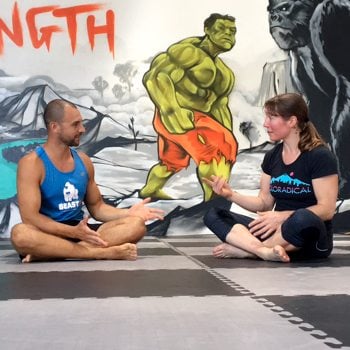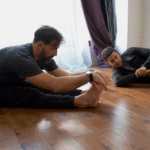One of the main reasons people come to me for training is to help them improve their flexibility, and that’s because flexibility is a tough thing for most people to work on.
 Most people don’t know of any way to improve flexibility other than sitting and stretching for what seems like hours on end. And when they’ve tried that in the past, it didn’t work, and just plain sucked.
Most people don’t know of any way to improve flexibility other than sitting and stretching for what seems like hours on end. And when they’ve tried that in the past, it didn’t work, and just plain sucked.
So they come to us looking for help.
If you’re a trainer, I’m sure you’ve had good success with many of your clients, but we’ve all had those few clients who are naturally quite stiff and don’t respond as well to the typical stretching methods.
These clients will often get frustrated and want to give up. Hell, you may get frustrated and want to give up!
Don’t give up just yet. Over the next few minutes, I’ll share four strategies that have worked for me, my clients, and tens of thousands of my clients over the years. Use these strategies to help even your most restricted clients overcome their limitations and make the progress they want in their training with you.
Why is Your Client Having Such a Hard Time With Flexibility?
 In a previous article, I discussed how some clients may have the strength and flexibility to perform a certain skill, but lack the motor control to learn that skill the way you might usually teach it.
In a previous article, I discussed how some clients may have the strength and flexibility to perform a certain skill, but lack the motor control to learn that skill the way you might usually teach it.
But what if your client really doesn’t have the flexibility necessary to do the things she wants to do?
We all have different natural tendencies and abilities. For some people, flexibility comes relatively easily, while for others, it’s something they really struggle with. But even for those who are naturally inflexible, improving flexibility is absolutely doable.
As a coach to someone with limited flexibility, though, you may have to adjust certain aspects of your teaching style to accommodate clients like this.
The first thing you have to figure out is what’s causing your client to struggle so much with flexibility. Is she new to training and hasn’t really had time to ease her body into new ranges of motion? Has she had past or recent injuries that are limiting her mobility? Is everyone in her family stiff?
Sometimes, it’s very clearly a mindset issue. Your client has convinced herself she’s inflexible and doesn’t see any way out.
Whatever is going on, it’s important that you, as her coach, understand where your client is coming from so that you can adjust your approach accordingly and meet her in the middle.
I’ve found the following four strategies to be helpful with my clients who just can’t seem to improve their flexibility.
1. Help Your Client Cultivate Patience
 Training for flexibility is something that requires a lot of patience–this includes patience on the part of your client as well as on your part as the trainer.
Training for flexibility is something that requires a lot of patience–this includes patience on the part of your client as well as on your part as the trainer.
Except for those rare people to whom flexibility comes easily, this process takes time, and some trial and error. The Focused Flexibility method has helped many people make faster progress than with random stretching programs, but it’s still not something that’s going to happen overnight.
When you see your clients getting frustrated, the answer is not to tell them to just “be patient.” You know as well as I do that’s a lot harder than it sounds.
Instead, you’ll want to pay close attention to how your client is feeling, and when you start to see that frustration creeping up, use strategies that will nip that frustration in the bud, with encouragement and positive reinforcement.
Here are a couple of strategies you can try:
- Start an accountability group–This is an idea I got from one of our GMB Trainers, Rose Calucchia. She creates small texting groups for her clients who are working on flexibility. Rose says, “Whoever does the stretches first each day texts the whole group letting us know. This reminds others to do it and adds an element of accountability.” Similarly, she’ll also pair up clients who are working toward the same goal, so they can text each other every day to keep each other accountable (she’s on these texting threads as well to offer support). I recently incorporated a similar strategy, using a private Facebook group for my flexibility clients. I have monthly challenges that keep them motivated and make the process a lot more fun.
- Help your client develop a growth mindset–If you see that your client is getting down on himself for not being able to progress at the level he wants to, you can work with him on developing a growth mindset (something I talked about in my previous article on motor control as well). The growth mindset will allow him to move away from the need for instant gratification, which ultimately leads to disappointment whenever things get difficult.
Patience is much more about mindset than anything else, so it’s important to use strategies that will help your client feel encouraged and proud of the work they’re putting in.
Accountability can play a big role here, because it can help your clients see that the process takes time for other people as well, but progress does happen. Not only will you be providing encouragement for your client, but they’ll also be getting encouragement from others going through the same thing.
2. Go for the “Wins”
 Most people know which areas are tighter than others, but you may have some clients who think they are stiff everywhere. Realistically, even someone who’s inflexible throughout the body will have some areas that are easier to improve than others.
Most people know which areas are tighter than others, but you may have some clients who think they are stiff everywhere. Realistically, even someone who’s inflexible throughout the body will have some areas that are easier to improve than others.
Success spurs success, so it’s important to give your clients some “wins,” especially early on.
Here are a couple of ways you can do that:
- Focus on the “wins” first–With this approach, you’ll spend most of your time focusing on the areas that will yield results quicker. Let’s say your client has very tight hamstrings, but her calves are not quite as tight. Spend a couple of weeks working on improving calf flexibility before you spend too much time on the hamstrings. You may want to do the minimum amount of work on the hamstrings, but spend a lot more time on the calves.
- Bracket harder areas with those “wins”–Another way of approaching this is to bracket harder areas with easier areas. So, work on an easier “feel-good” stretch, then do a harder one, then finish off with another easy “feel-good” one.
Both of these options are essentially accomplishing the same thing. They’re tapping in to good feelings for your clients, which is important because it will help them come away from the session with a sense of achievement and positive sentiment.
One of the problems many people have with stretching is that they feel like they have to do a bunch of stretches they hate.
This is only going to make them stay away from stretching of any kind, which inevitably means they will not see the progress they want with their flexibility. There are tons of approaches to flexibility training, and they all can work, but the most important thing is finding an approach your client won’t hate.
The best flexibility routine is one that your client will do consistently. 15-20 minutes every day is much more beneficial than a hardcore session once a week.
3. Track Progress Through Meaningful Actions
 Most people measure flexibility progress by just retesting a particular stretch. For instance, if your client really wants to get the splits, he’ll likely check periodically to see if he’s “gotten the splits” yet.
Most people measure flexibility progress by just retesting a particular stretch. For instance, if your client really wants to get the splits, he’ll likely check periodically to see if he’s “gotten the splits” yet.
There’s nothing wrong with that, per se, but considering the splits can take a long time to get, it can make your client feel discouraged if week after week, he hasn’t reached his goal yet. And as we just talked about in the previous section, it’s important to encourage positive associations with your stretching program.
- Tie progress to real life applications–Instead of measuring progress based on the changes in a particular stretch, it’s more meaningful to look at changes in real-life positions or movements. For instance, if your client has limited shoulder mobility and has struggled with reaching behind herself to get something from the backseat of her car, that might be a good “check” for her progress. Or if hip mobility is an issue, she might have a hard time crawling under the sink to fix a leaky pipe. Checking that ability from time to time will be a good way to track progress.
- Follow stretches with fun movements–When coaching flexibility, I always incorporate some fun “movement” time afterward, where they are bending or crawling or reaching in an active way, using the range of motion we just stretched. This has multiple benefits including developing additional strength and motor control in that range, and “tricking” them into spending more time in that range of motion (= more gainzzz). And it’s a fun, rewarding way to end a hard session of training flexibility.
As a coach, you can work with your client on identifying specific ways her current level of mobility is holding her back, so that she can pay attention to how her body is responding to your stretching program.
This will make the process much more meaningful, as she realizes she’s gaining freedom of movement in her daily life.
4. Share Success Stories
 Flexibility progress will be quite different from client to client, and for that very inflexible client, it might be discouraging for him to see others making progress faster than he is.
Flexibility progress will be quite different from client to client, and for that very inflexible client, it might be discouraging for him to see others making progress faster than he is.
He might also look at you as his trainer and deem you as “naturally flexible,” even if that’s not the case.
It can be helpful in these cases to share success stories from clients, or even people you see online, who’ve struggled with mobility and have had good success with improving their flexibility.
One example I often point to is Charlie, who started out with limited flexibility at age 63 but stayed consistent in his practice and got great results that helped him in his daily and professional life as a carpenter.
And if you’ve had clients who’ve been successful in your program, ask them if you can put your client in touch with them to get encouragement.
When your client is really struggling with improving flexibility, it can be so helpful to hear that someone else has gone through the same thing and has come out on the other side to tell the tale.
Free Your Clients’ Restrictions–the Smart Way
 For some people, flexibility comes pretty easily–maybe you’re one of those rare few.
For some people, flexibility comes pretty easily–maybe you’re one of those rare few.
But more likely than not, you’ve struggled to make progress in your own flexibility, so you understand when one of your clients is having a particularly tough time.
Even if you understand where they’re coming from, though, it can be pretty frustrating, as their coach, when things don’t seem to be working.
The strategies I shared above will help you and your clients work through those frustrating times, and continue making the progress you both want.
Another key part of the puzzle, however, is the approach to stretching you’re using.
Our GMB Mobility program approaches stretching in a targeted way so your efforts aren’t wasted, and you can address the areas that really need the most work.
Help Your Clients Gain the Flexibility They Need
Quit guessing at where your clients need help. GMB Mobility helps you assess exactly where they (and you!) need the most help.






